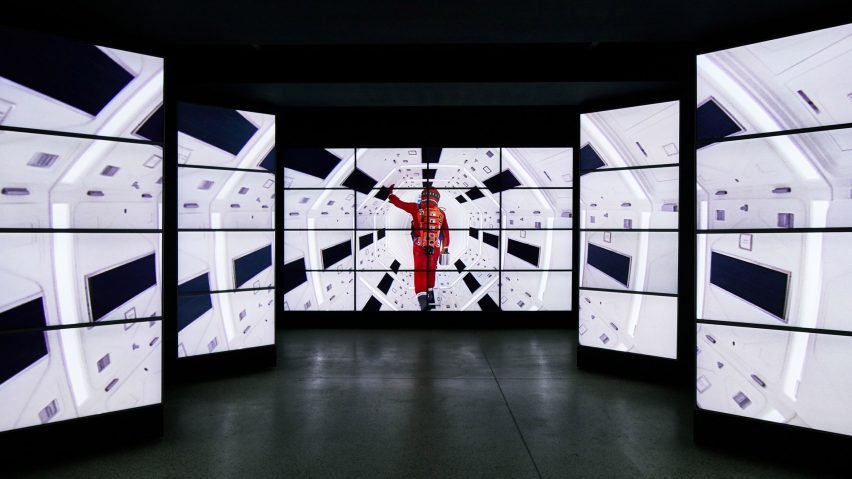Design Museum director Deyan Sudjic has paid tribute to Stanley Kubrick, as an exhibition exploring the life and work of the legendary film director opens at the museum today.
Stanley Kubrick: The Exhibition showcases over 500 objects, including production documents, props, set designs and storyboards from the American director's "genre-defining" films, such as The Shining, Barry Lyndon, 2001: A Space Odyssey, Full Metal Jacket and A Clockwork Orange.
Coinciding with the 20th anniversary of Kubrick's death, the exhibition – curated by Deyan Sudjic and designed by Pentagram partner Marina Willer – explores the filmmaker's entire creative design process, from storytelling and set design, to directing and editing.
Sudjic said the director's talent was in his ability to make any genre relevant and exciting.
"Every film he made was so different. He explored every genre – historical, costume drama, science fiction, horror," he told Dezeen. "You get a sense of the drama and excitement of filmmaking."
The exhibition has been shown in 15 cities. Unlike previous exhibitions, however, which have shown Kubrick's work chronologically, Sudjic wanted to divide the exhibition thematically into seven sections, with a special focus on design.
Sudjic also wanted the exhibition to examine Kubrick's relationship with Britain, where the filmmaker worked and lived for 40 years.
"We've taken this travelling exhibition to reflect our approach to it: design and the importance of London," he told Dezeen. "Even Lolita was filmed in London!"
"Clockwork Orange, for example, is a hymn to brutalism or maybe, a brutal demolition of brutalism, so the exhibition shows shooting locations like Thames Mead and Brunel University's auditorium in Uxbridge, which is The Ludovico Institute where Malcolm Mcdowell is tortured," he explained.
"Back then it was seen as all that could go wrong with concrete and now it's a listed building," he added.
Visitors enter the exhibition via a corridor flanked with two digital screens on either side, playing clips of Kubrick's films.
This is intended to mimic the director's one-point perspective, a style of filming that favours near-perfect symmetrical shots.
The floor is clad in a patterned carpet that has been replicated to resemble the graphic orange and brown carpet from Kubrick's classic horror film The Shining.
The first room looks at Kubrick's war films – Paths of Glory, Spartacus and Full Metal Jacket – and includes props such as platoon flags and Born-to-Kill helmet worn by Private Joker in Full Metal Jacket.
Another room focuses on Kubrick's "moral controversies", Lolita and A Clockwork Orange, highlights of which include the record deck-turntable used by the antagonist Alex to play Beethoven in A Clockwork Orange.
"One of the things Kubrick was good at was looking at the very near future. Clockwork Orange is not now but it's close by so the films were filled with sets that suggest that idea," said Sudjic.
Also featured is the film's bright red Valentine typewriter, originally designed by Ettore Sottsass and Perry King in 1968, and the Allen Jones-inspired "transgressive woman furniture objects" displayed in the Milk Bar.
There is also a room dedicated to The Shining and includes the Adler Typewriter used by Jack Nicolson's character, as well as the costumes worn by Lisa and Louise Burns, who play the twins.
Other rooms are themed around Kubrick's films Eyes Wide Shut, Dr Strangelove and Barry Lydon.
The final room is dedicated to the filmmaker's Oscar-winning 2001: Space Odyssey and includes the original ape costumes worn by actors in the film's opening and a replica of the glossy white Howard Johnson Earthlight Room.
"Without Space Odyssey, there would be no Blade Runner and no Star Wars," said Sudjic. "Kubrick was the first person to take science fiction as a genre away from bug-eyed monsters and cardboard space rockets."
"The cutlery used by the astronauts in 2001: Space Odyssey is Arne Jacobsen and the furniture in the Earthlight Room is Olivier Mourgue's Djinn chairs," he explained.
"He was using the present to create an idea of what the future might look like," he continued.
Stanley Kubrick: The Exhibition takes place at London's Design Museum between 26 April and 15 September 2019.
"Nobody could craft a movie better than Stanley Kubrick. He is an inspiration to us all. Stanley was a chameleon with the astonishing ability to reinvent himself with each new story he told," said director Steven Spielberg.
"I defy anyone who just happens upon a Kubrick film while channel surging to try with all your might to change the station – I have found this to be impossible," he explained.
Photography is by Ed Reeve

